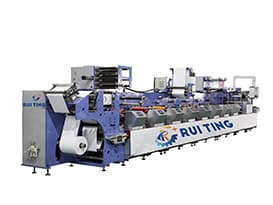Blog

Here is a general guide on how to use a Roll Sheet Cutting Machine:
1. Preparation
--Machine Inspection: Before using the roll sheet cutting machine, carefully inspect the machine for any visible damages, loose parts, or signs of wear. Check the blade condition to ensure it's sharp and properly installed.
--Material Preparation: Prepare the roll of sheet material you want to cut. Make sure it's the correct type and size for your cutting requirements. Check the roll's core diameter and width to ensure it fits properly on the machine's unwind stand.
--Safety Precautions: Put on appropriate personal protective equipment such as safety glasses and gloves. Ensure that the work area around the machine is clean, well - lit, and free from any potential tripping hazards.
2. Setup
--Loading the Roll: Place the roll of sheet material onto the unwind stand of the cutting machine. Secure it in place according to the machine's design. Some machines may have clamping mechanisms or shafts to hold the roll firmly.
--Adjusting the Tension: Set the correct tension for the sheet material. This is crucial to ensure smooth feeding through the machine and accurate cutting. The tension adjustment mechanism may vary depending on the model of the cutting machine.
--Setting the Cutting Parameters: Use the control panel of the machine to set the desired cutting length, width, and quantity. You may also need to adjust the cutting speed according to the material type and thickness. Some advanced machines allow you to program different cutting patterns or sequences.
3. Operation
--Starting the Machine: Once all the settings are adjusted, turn on the power of the roll sheet cutting machine. Some machines may have a warm - up period, especially if they use a heated cutting blade or other thermal components. Wait for the machine to initialize and reach the proper operating state.
Feeding the Material: Start the material feed mechanism, which will slowly unwind the sheet material and feed it through the cutting area. Make sure the material is feeding smoothly and not getting stuck or wrinkled.
--Monitoring the Cutting Process: As the material is being cut, closely monitor the process. Check that the cuts are clean, accurate, and at the desired lengths and widths. If you notice any problems such as uneven cuts, blade jamming, or material misalignment, immediately stop the machine using the emergency stop button (if available).
--Collecting the Cut Sheets: As the cut sheets are produced, have a collection system in place to neatly stack or package them. This could be a conveyor belt, a bin, or a pallet depending on the size and quantity of the cut sheets.
4. Shutdown and Maintenance
--Shutting Down the Machine: When you have finished cutting the desired amount of sheets, stop the material feed and the cutting mechanism. Turn off the power to the machine and allow it to come to a complete stop.
--Cleaning and Maintenance: After each use, clean the cutting area to remove any scraps of material, debris, or residue from the cutting blade. Check the blade for any signs of damage and perform routine maintenance such as lubricating moving parts and tightening any loose screws or bolts. Store the machine in a clean and dry environment to prevent rust and other damage.

Latest News
Exhibition 2023 labelexpo Asia
The 2023 labelexpo Asia show we participated in in December was a complete success. I am v...
Jun 14,2024
Slitting is a key manufacturing process cutting wide flexible materials (paper, films, foi...
Nov 28,2025
A flexo printing machine is a fast, versatile system that uses flexible plates and various...
Nov 14,2025
GET A QUOTE